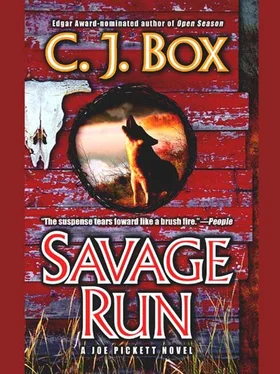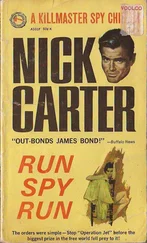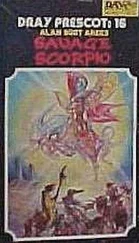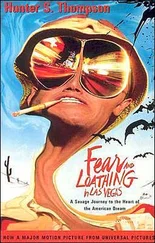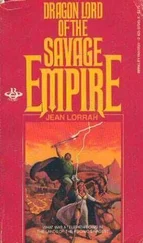C. Box - Savage Run
Здесь есть возможность читать онлайн «C. Box - Savage Run» весь текст электронной книги совершенно бесплатно (целиком полную версию без сокращений). В некоторых случаях можно слушать аудио, скачать через торрент в формате fb2 и присутствует краткое содержание. Жанр: Триллер, на английском языке. Описание произведения, (предисловие) а так же отзывы посетителей доступны на портале библиотеки ЛибКат.
- Название:Savage Run
- Автор:
- Жанр:
- Год:неизвестен
- ISBN:нет данных
- Рейтинг книги:3 / 5. Голосов: 1
-
Избранное:Добавить в избранное
- Отзывы:
-
Ваша оценка:
- 60
- 1
- 2
- 3
- 4
- 5
Savage Run: краткое содержание, описание и аннотация
Предлагаем к чтению аннотацию, описание, краткое содержание или предисловие (зависит от того, что написал сам автор книги «Savage Run»). Если вы не нашли необходимую информацию о книге — напишите в комментариях, мы постараемся отыскать её.
Savage Run — читать онлайн бесплатно полную книгу (весь текст) целиком
Ниже представлен текст книги, разбитый по страницам. Система сохранения места последней прочитанной страницы, позволяет с удобством читать онлайн бесплатно книгу «Savage Run», без необходимости каждый раз заново искать на чём Вы остановились. Поставьте закладку, и сможете в любой момент перейти на страницу, на которой закончили чтение.
Интервал:
Закладка:
Something didn’t sit right.
Joe’s gaze slowly rose from the antelope in the sagebrush hills toward the blue-gray mountains that dominated the horizon. The Vee Bar U stretched as far as he could see, counting Forest Service leases. The ranch was one of the crown jewels of Twelve Sleep County, sweeping from the highway to up and over those mountains. And somewhere up there, practically inaccessible, was the place called Savage Run.
The canyon called Savage Run cut a brutal slash through the center of incredibly rugged and almost impenetrable Wyoming mountain wilderness. The Middle Fork of the Twelve Sleep River, which created the canyon over millions of years of relentless shaving and slicing, was now a trickle due to upstream irrigation. But the results-knife-sharp walls, a terrifying distance from the rim to the narrow canyon floor, virtually no breaks or cracks through the rocks to assure a crossing-was geologically stunning. The canyon was so steep and narrow that sunlight rarely shone on the stream. The canyon cut through eight different geological strata. While the rim was twenty-first century Wyoming in drought, the floor was pre-Jurassic rain forest. The last time the floor was exposed, Tyrannosaurus rex peered through gaping eyes at prey.
The legend of Savage Run came from the story of a band of a hundred Cheyenne Indians-mainly the elderly, women, and children-who were camped near the eastern rim of the canyon while their men were on an extended buffalo hunt in the Powder River country. The band was unaware of the Pawnee warriors who had been following them for days, and unaware that the Pawnees stayed hidden while the hunting party rode away.
The Pawnee had planned to attack fast and hard, both to claim their special reward from the U.S. Army of $10 per scalp as well as to gain access to prime Rocky Mountain foothills hunting land when the Indian Wars were finally over. They were also after the large herd of Cheyenne horses.
Somehow, the band of Cheyenne learned of the impending attack before nightfall. The Pawnees had no idea they had been discovered, and they dry-camped and prepared for a vicious dawn attack.
Before first light, with weapons drawn and already painted black and white for war, the Pawnees swooped up the draws and flowed toward the Cheyenne camp. When the Pawnees moved in on the camp they found only the tipi rings, still-warm campfire embers from the previous night, and more than a hundred dead horses, their throats slashed. It appeared to the Pawnee that the Cheyenne had literally flown away. The Pawnee knew the logistics of moving all of those people out, and they knew that it should have been impossible for the Cheyenne to get by them at night. There was no way the band of Cheyenne had flown through them, the Pawnees thought, and the only escape had been away from them, toward a canyon that could not be crossed. Furious, they pursued.
What the Pawnee found when they reached the rim of the canyon was evidence of an otherworldly occurrence. The band of Cheyenne was gone, but there was visible evidence of their flight. Somehow, remarkably, the entire band had descended the sheer cliffs to the bottom and climbed back out on the other side. The evidence, hundreds of feet below, was the number of telltale discarded tipi poles and bits of hair and clothing clinging to spiny brush. The entire Cheyenne band-the aged men and women, their grandchildren and daughters, the few able men in the camp, as the story went-had somehow, one by one, climbed down the canyon side to the Middle Fork, forded the river, and climbed up the other side to their escape. The tipi poles had been discarded sometime during the night, and they now stood, to the Pawnee, as awful proof that the incomprehensible had happened: The Pawnee had lost their advantage of surprise, lost the horses, and lost the Cheyenne.
The Pawnee chose not to even try to pursue the Cheyenne. They admired the escape and were somewhat awed by the pure determination of the people who had managed such an escape. That the Cheyenne would leave in the middle of the night, risking the lives of all, kill their horses, and succeed was beyond anything the Pawnee had ever encountered. It was that respect, as the story went, that caused the Pawnee to turn their horses around and go home to Fort Laramie. In Pawnee, the roughly translated name they gave the canyon was “Place Where the Cheyenne Ran Away from Us.” Soldiers who heard the story, and who were at war at the time with the Cheyenne (who they regarded as barely human), renamed the geological anomaly “Savage Run,” although none of them ever found the place or really knew where it was. The legend of Savage Run was passed on. Eventually, several white elk hunters claimed they had found the passage. A national historian wrote about it well enough to create interest; thus the move for National Monument designation. But outside of a few American Indian hunting guides and the original elk hunters, few were exactly sure where the passage across the canyon was located.
Joe looked at Maxine, and the Labrador looked back with her big brown eyes. Labradors forgave everything. Joe wished he could.
He wished he could get a handle on the uncharacteristic hatred he felt toward hobby rancher/lawyer Jim Finotta. But he sure wanted to get that son of a bitch.
5
Three days later, Joe Pickett sat idly sipping coffee and waiting for Marybeth to return with the newspaper from her morning walk. She walked every day, even through horizontal snowstorms in the winter, and was strong enough now that she could pitch fifty-pound bales of hay from the stack in her barn. The exercise, she said, had helped her recover her balance and strength after her shooting injury, and she never missed a morning. She was proud of the fact that she could now handle all of the duties at the stables, where she worked part-time, including tacking up fifteen-hand horses and working them in the round pen. Marybeth often went to her other part-time job at the Twelve Sleep County Municipal Library smelling of horses. It was a good smell, Joe thought, and was pleased that Marybeth wasn’t ashamed of it. The two jobs offered enough flexibility that she was able to see her children off to school in the morning and be there when they returned.
“Why didn’t you tell me that the man killed in the mountains was Stewie Woods? ” Marybeth fired at Joe as she came into the kitchen. The Saddlestring Roundup was clutched in her fist.
Joe was raising a mug of coffee to his mouth. Sheridan, Lucy, and April were still bleary-eyed, in their pajamas, and were distractedly eating bowls of breakfast cereal. Everyone’s eyes were on Marybeth; Joe thought the girls all looked as if they had been caught in the act of committing a crime.
“How could you not tell me, Joe Pickett?” she asked angrily, her voice getting louder with each word. Joe had not moved. The coffee cup was still poised for a sip. He knew that whatever he said now would not be the right thing to say.
“Barnum called and said the victim was named Allan Stewart Woods,” Joe said lamely. “I didn’t make the connection at the time to Stewie Woods.”
She glared at him with eyes that could melt ice.
“Besides,” Joe said, “why is it so important?”
Suddenly, Marybeth gave an angry little cry, threw the newspaper onto a chair, and stormed up the stairs to the bedroom, where she slammed the door and noisily threw the lock.
Joe and the girls stared dumbly at the space Marybeth had just occupied.
“What’s wrong with Mom?” Sheridan asked.
“She’s just upset,” Joe answered. “Everything’s fine.”
“Who is Stewie Woods?” Lucy asked Sheridan.
Sheridan shrugged, and turned back to her breakfast, giving Lucy a “please be quiet” glare.
Читать дальшеИнтервал:
Закладка:
Похожие книги на «Savage Run»
Представляем Вашему вниманию похожие книги на «Savage Run» списком для выбора. Мы отобрали схожую по названию и смыслу литературу в надежде предоставить читателям больше вариантов отыскать новые, интересные, ещё непрочитанные произведения.
Обсуждение, отзывы о книге «Savage Run» и просто собственные мнения читателей. Оставьте ваши комментарии, напишите, что Вы думаете о произведении, его смысле или главных героях. Укажите что конкретно понравилось, а что нет, и почему Вы так считаете.
